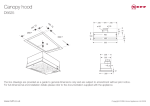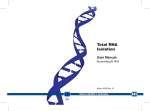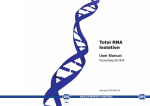Download E.Z.N.A.®Soil DNA Kit
Transcript
E.Z.N.A.® Soil DNA Kit D5625-00 5 preps D5625-01 50 preps D5625-02 200 preps April 2013 E.Z.N.A.® Soil DNA Kit Table of Contents Introduction and Overview...........................................................2 Kit Contents/Storage and Stability.............................................3 Preparing Reagents...........................................................................4 Soil DNA Protocol...............................................................................5 Purification of DNA Isolated using Other Methods...............9 Troubleshooting Guide..................................................................10 Ordering..............................................................................................11 Manual Revision: April 2013 Innovations in nucleic acid isolation 1 Introduction and Overview Introduction The E.Z.N.A.® Soil DNA Kit allows rapid and reliable isolation of high-quality genomic DNA from various soil samples. Up to 1 gram of soil samples can be processed in less than 60 minutes. The system combines the reversible nucleic acid-binding properties of HiBind® matrix with the speed and versatility of spin column technology to eliminate PCR inhibiting compounds such as humic acid from soil samples. Purified DNA is suitable for PCR, restriction digestion, and hybridization techniques. There are no organic extractions thus reducing plastic waste and hands-on time to allow multiple samples to be processed in parallel. Overview If using the E.Z.N.A.® Soil DNA Kit for the first time, please read this booklet to become familiar with the procedure. Soil sample is homogenized and then treated in a specially formulated buffer containing detergent. Humic acid, proteins, polysaccharides, and other contaminants are subsequently precipitated after a heat-freeze step. Contaminants are further removed by extraction steps. Binding conditions are then adjusted and the sample is applied to an HiBind® DNA Mini Column. Two rapid wash steps remove trace contaminants and pure DNA is eluted in water or low ionic strength buffer. Purified DNA can be directly used in downstream applications without the need for further purification. New in this Edition: • Equilibration Buffer (used in the Troubleshooting section) is no longer included with this kit. • Equilibration Buffer can be replaced with 3M NaOH provided by the user. 2 Kit Contents Product Number Purifications D5625-00 D5625-01 D5625-02 5 preps 50 preps 200 preps HiBind® DNA Mini Columns 5 50 200 2 mL Collection Tubes 10 100 400 Glass Beads 3g 30 g 110 g HTR Reagent 1.2 mL 12 mL 45 mL 6 mL 60 mL 220 mL SLX-Mlus Buffer DS Buffer 0.6 mL 6 mL 22 mL P2 Buffer 3 mL 25 mL 60 mL XP1 Buffer 4 mL 40 mL 160 mL Elution Buffer 3 mL 30 mL 120 mL SPW Wash Buffer 2 mL 20 mL 3 x 25 mL P P P User Manual Storage and Stability Most components of the E.Z.N.A.® Soil DNA Kit should be stored at 22-25°C. Store the HTR Reagent at 2-8°C. Under these conditions, DNA has successfully been purified and used for PCR after 24 months of storage. During shipment, or storage in cool ambient conditions, precipitates may form in some buffers. It is possible to dissolve such deposits by warming the buffer to 55°C. 3 Preparing Reagents Dilute SPW Wash Buffer with 100% ethanol as follows and store at room temperature. 4 Kit 100% Ethanol to be Added D5625-00 8 mL D5625-01 80 mL D5625-02 100 mL per bottle E.Z.N.A.® Soil DNA Kit Protocol E.Z.N.A.® Soil DNA Protocol Materials and Equipment to be Supplied by User: • • • • • • • • • • Microcentrifuge capable of at least 13,000 x g and 4°C Centrifuge with rotor for 15 mL centrifuge tubes Vortexer 1.5 mL microcentrifuge tubes 2 mL microcentrifuge tubes 15 mL centrifuge tubes Incubator capable of 70°C 100% ethanol Isopropanol Optional: Incubator capable of 95°C Before Starting: • • • • • • Prepare the SPW Wash Buffer as instructed in the “Preparing Reagents” section on Page 4 Heat Elution Buffer to 70°C Set a incubator to 70°C Prepare ice bucket Set a microcentrifuge to 4°C Optional: For gram-positive bacteria, set a incubator or water bath to 95°C 1. Transfer 500 mg glass beads to a 15 mL centrifuge tube. 2. Add 0.2-1.0 g soil sample to the glass beads. 3. Add 1 mL SLX-Mlus Buffer. Vortex at maximum speed for 3-5 minutes to lyse samples. Note: For best result, a mixer mill, such as GenoGrinder 2010, Fastprep-24®, Mixer Mill MM 300®, should be used. 4. Add 100 μL DS Buffer. Vortex to mix thoroughly. 5. Incubate at 70°C for 10 min. Briefly vortex the tube once during the incubation. 5 E.Z.N.A.® Soil DNA Kit Protocol Optional: For isolation of DNA from gram-positive bacteria, do a second incubation at 95°C for 2 minutes. 6. Centrifuge at 3,000 rpm for 3 minutes at room temperature. 7. Transfer 800 µL the supernatant into a new 2 mL microcentrifuge tube. 8. Add 270 µL P2 Buffer. Vortex to mix thoroughly. 9. Incubate on ice for 5 minutes. 10. Centrifuge at ≥13,000 x g for 5 minutes at 4°C. 11. Carefully transfer the supernatant to a new 2 mL microcentrifuge tube. 12. Add 0.7 volumes isopropanol. Mix thoroughly by inverting tube for 20-30 times. Note: If the soil contains very low DNA, incubate the sample at -20°C for 1 hour. 13. Centrifuge at ≥13,000 x g for 10 minutes at 4°C. 14. Carefully aspirate and discard the supernatant. Do not disturb the DNA pellet. 15. Invert the tube on a absorbent paper for 1 minute to drain the liquid. Note: It is not necessary to dry the DNA pellet. 16. Add 200 μL Elution Buffer. Vortex for 10 seconds. 17. Incubate at 70°C for 10-20 minutes to dissolve the DNA pellet. 6 E.Z.N.A.® Soil DNA Kit Protocol 18. Add 100 μL HTR Reagent. Vortex to mix thoroughly. Note: Completely resuspend HTR Reagent by shaking the bottle before use. 19. Let sit at room temperature for 2 minutes. 20. Centrifuge at ≥13,000 x g for 2 minutes. 21. Transfer cleared supernatant to a new 2 mL microcentrifuge tube. Note: If supernatant still has a dark color from the soil, repeat Steps 18-20 for a second HTR Reagent step. 22. Add an equal volume XP1 Buffer. Vortex to mix thoroughly. 23. Insert a HiBind® DNA Mini Column into a 2 mL Collection Tube provided in this kit. 24. Transfer the sample from Step 22 to the HiBind® DNA Mini Column. 25. Centrifuge at 10,000 x g for 1 minute at room temperature. 26. Discard the filtrate and reuse the Collection Tube. 27. Add 300 µL XP1 Buffer. 28. Centrifuge at 10,000 x g for 1 minute. 29. Discard the filtrate and the Collection Tube. 30. Transfer the HiBind® DNA Mini Column into a new 2 mL Collection Tube. 7 E.Z.N.A.® Soil DNA Kit Protocol 31. Add 700 µL SPW Wash Buffer. Note: SPW Wash Buffer must be diluted with ethanol before use. Please see the “Preparing Reagents” section on Page 4 for instructions. 32. Centrifuge at 10,000 x g for 1 minute. 33. Discard the filtrate and reuse the Collection Tube. 34. Repeat Steps 31-33 for a second SPW Wash Buffer wash step. 35. Centrifuge the empty HiBind® DNA Mini Column at ≥13,000 x g for 2 minutes at room temperature. Note: This step is critical in removing residual ethanol that may interfere with downstream applications. 36. Transfer the HiBind® DNA Mini Column into a clean 1.5 mL microcentrifuge tube. 37. Add 30-100 µL Elution Buffer heated to 70°C directly onto the center of HiBind® membrane. 38. Incubate at 70°C for 10-15 minutes. 39. Centrifuge at ≥13,000 x g for 1 minute. 40. Repeat Steps 37-39 for a second elution step. 41. Discard the HiBind® DNA Mini Column and store eluted DNA at -20°C. 8 E.Z.N.A.® Soil DNA Kit Protocol E.Z.N.A.® Soil DNA Protocol - Purification of DNA Isolated using Other Methods Materials and Equipment to be Supplied by User: • • • • • Microcentrifuge capable of at least 13,000 x g and 4°C 1.5 mL microcentrifuge tubes 2 mL microcentrifuge tubes Incubator capable of 70°C 100% ethanol Before Starting: • • • • Prepare the SPW Wash Buffer as instructed in the “Preparing Reagents” section on Page 4. Heat Elution Buffer to 70°C Set a incubator to 70°C Set a microcentrifuge to 4°C 1. Adjust the volume of the DNA sample to 200 μL with Elution Buffer. 2. Add 100 μL HTR Reagent. Vortex to mix thoroughly. Note: Completely resuspend HTR Reagent by shaking the bottle before use. 3. Let sit at room temperature for 2 minutes. 4. Centrifuge at ≥13,000 x g for 2 minutes. 5. Transfer cleared supernatant to a new 2 mL microcentrifuge tube. Note: If supernatant still has a dark color from the soil, repeat Steps 2-4 for a second HTR Reagent step. 6. Follow Steps 22-41 beginning on Page 7 of the Soil DNA Protocol. 9 Troubleshooting Guide Please use this guide to troubleshoot any problems that may arise. For further assistance, please contact the technical support staff, toll free, at 1-800-832-8896. Problem Cause Solution Inefficient elimination of inhibitory compounds Repeat with a new sample, be sure to mix the sample with HTR Reagent thoroughly. Salt contamination Make sure the column is dried before the elution. Wash the column with extra SPW Wash Buffer. Poor homogenization of sample Repeat the DNA isolation with a new sample, be sure to vortex the sample with SLX-Mlus and glass beads thoroughly. DNA washed off. SPW Wash Buffer must be diluted with ethanol before use. Column matrix lost binding capacity during storage Add 100 µL 3M NaOH to the column prior to loading the sample. Centrifuge at 10,000 x g for 30 seconds. Discard the filtrate. BSA not added to PCR mixture Add BSA to a final concentration of 0.1 μg/mL to the PCR mixture. Too much DNA inhibits PCR reactions Dilute the DNA used in the downstream application if possible. Non-specific bands in downstream PCR Use hot-start Taq polymerase mixture Inhibitory substance in the eluted DNA. Check the A260/230 ration. Dilute the elute to 1:50 if necessary Residual ethanol in the elute Completely dry the column before elution A260/230 ratio is low Low DNA Yield or no DNA Yield Problems in downstream applications Little or no Insufficient centrifugal supernatant after force initial centrifuge step Check the centrifugal force and increase the centrifugal time if necessary Sample can not pass through the column Check the centrifugal force and increase the time of centrifugation 10 Clogged column Ordering Information The following components are available for purchase separately. (Call Toll Free at 1-800-832-8896) Product HiBind® DNA Mini Columns, 200 columns Part Number DNACOL-02 P2 Buffer, 60 mL PD076 SPW Wash Buffer, 40 mL PDR045 Elution Buffer, 100 mL PDR048 HiBind®, E.Z.N.A.®, and MicroElute® are registered trademarks of Omega Bio-tek, Inc. PCR is a patented process of Hoffman-La Roche. Use of the PCR process requires a license. 11 Notes: 12





































